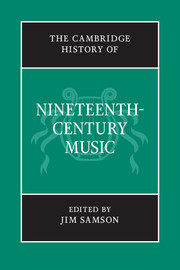Book contents
- Frontmatter
- Part One 1800–1850
- Part Two 1850–1900
- 11 Progress, modernity and the concept of an avant-garde
- 12 Music as ideal: the aesthetics of autonomy
- 13 The structures of musical life
- 14 Opera and music drama
- 15 Beethoven reception: the symphonic tradition
- 16 Words and music in Germany and France
- 17 Chamber music and piano
- 18 Choral culture and the regeneration of the organ
- 19 Music and social class
- 20 Nations and nationalism
- 21 Styles and languages around the turn of the century
- Chronology
- Institutions
- Personalia
- Index
- References
15 - Beethoven reception: the symphonic tradition
from Part Two - 1850–1900
Published online by Cambridge University Press: 28 March 2008
- Frontmatter
- Part One 1800–1850
- Part Two 1850–1900
- 11 Progress, modernity and the concept of an avant-garde
- 12 Music as ideal: the aesthetics of autonomy
- 13 The structures of musical life
- 14 Opera and music drama
- 15 Beethoven reception: the symphonic tradition
- 16 Words and music in Germany and France
- 17 Chamber music and piano
- 18 Choral culture and the regeneration of the organ
- 19 Music and social class
- 20 Nations and nationalism
- 21 Styles and languages around the turn of the century
- Chronology
- Institutions
- Personalia
- Index
- References
Summary
Symphonic practice in later nineteenth-century Europe was no unitary activity that we should collapse into a crisp, linear narrative. The reality was messier. It would be more accurate to regard the world of orchestral composition as an arena of competing ideologies and diverse aims, a field of energy and circulation. To be sure, the energy was anything but random. Composers, performers, publishers, critics, academics, students and audiences channelled it through a flurry of enabling and constraining preconditions, historical and cultural circumstances sorted out differently by different groups. Among the most significant precondition was the idea of tradition – or, more to the point, the struggle over the presumed ownership of that tradition. By the second half of the century the European idea of the symphony as a high-status cultural achievement was nourished by lovingly shaped readings of the genre’s Austro-Germanic past. Commonly enough, the grounding shape was reinforced by a heroic tale: the ascent to the apex, Beethoven – embodying the long-sought liberation of the modern idea of greatness in instrumental music, the definitional moment of full symphonic adequacy, the ‘undeniable’ launching of ‘the new era of music’ (as Liszt put it in 1855) – followed by a crisis of continuation in subsequent decades.
Spurred also by external factors – technological, economic, political, ethnic-national – the symphonic crisis invited a number of solutions: it had been disseminated to several different publics on several different terms. As a result, by mid-century no central authority was able to establish a consensus concerning the best way to continue the tradition while still honouring its past.
- Type
- Chapter
- Information
- The Cambridge History of Nineteenth-Century Music , pp. 424 - 459Publisher: Cambridge University PressPrint publication year: 2001
References
- 7
- Cited by

